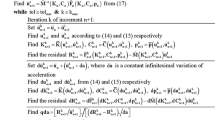Abstract
Transient nature of the loading conditions applied to the structural components makes dynamic analysis one of the important components in the design-analysis cycle. Time-varying forces and accelerations can substantially change stress distributions and cause a premature failure of the mechanical structures. In addition, it is also important to determine dynamic response of the structural elements to the frequency of the applied loads. In this paper we describe the first application of the meshfree Solution Structure Method (SSM) to the structural dynamics problems. SSM is a meshfree method which enables construction of the solutions to the engineering problems that satisfy exactly all prescribed boundary conditions. This method is capable of using spatial meshes that do not conform to the shape of a geometric model. Instead of using the grid nodes to enforce boundary conditions, it employs distance fields to the geometric boundaries and combines them with the basis functions and prescribed boundary conditions at run time. This defines unprecedented geometric flexibility of the SSM as well as the complete automation of the solution procedure. In the proposed approach we will use SSM to enforce initial and boundary conditions, while transient behavior is enforced by time marching schemes used to solve systems of ordinary differential equations. In the paper we will explain the key points of the SSM as well as investigate the accuracy and convergence of the proposed approach by comparing our results with the ones obtained using traditional finite element analysis. Despite in this paper we are dealing with 2D in-plane vibrations, the proposed approach has a straightforward application to model vibrations of 3D structures.





































Similar content being viewed by others
References
Bloomenthal J (1997) Introduction to implicit surfaces. Morgan Kaufmann Publishers, San Francisco
Causevic M, Mitrovic S (2011) Comparison between non-linear dynamic and static seismic analysis of structures according to European and US provisions. Bull Earthq Eng 9(2):467–489
Deierlein G, Reinhorn A, Willford M (2010) Nonlinear structural analysis for seismic design, a guide for practicing engineers. NEHRP Seismic Design Technical Brief No. 4. NIST GCR 10-917-5
Duchon C (1979) Lanczos filtering in one and two dimensions. J Appl Meteorol Climatol 18(8):1016–1022
Freytag M, Shapiro V, Tsukanov I (2006) Field modeling with sampled distances. Comput Aided Des 38(2):87–100
Freytag M, Shapiro V, Tsukanov I (2007a) Differentiable distance fields from scanned data. Technical report, University of Wisconsin-Madison. http://sal-cnc.me.wisc.edu
Freytag M, Shapiro V, Tsukanov I (2007b) Scan and solve: acquiring the physics of artifacts. In: Proceedings of the ASME 2007 international design engineering technical conferences and computers and information in engineering conference, Las Vegas, USA
Freytag M, Shapiro V, Tsukanov I (2011) Finite element analysis in situ. Finite Elem Anal Des 47:957–972
Fryazinov O, Vilbrandt T, Pasko A (2013) Multi-scale space-variant FRep cellular structures. Comput Aided Des 45(1):26–34
Kantorovich LV, Krylov V (1958) Approximate methods of higher analysis. Interscience Publisher, New York
Komzsik L (2003) The Lanczos method: evolution and application. Software, environments and tools. Society for Industrial and Applied Mathematics
Kosta T, Tsukanov I (2014a) Meshfree natural vibration analysis of 2D structures. Comput Mech 53(2):283–296. doi:10.1007/s00466-013-0907-y
Kosta T, Tsukanov I (2014b) Three-dimensional natural vibration analysis with meshfree solution structure method. J Vib Acoust (in print)
Krysl P (2006) A pragmatic introduction to the finite element method for thermal and stress analysis: with the Matlab toolkit Sofea. World Scientific, Singapore
Lanczos C (1988) Applied analysis. Dover books on mathematics. Dover Publications, New York. http://books.google.com/books?id=6E85hExIqHYC
Pasko A, Adzhiev V (2004) Function-based shape modeling: mathematical framework and specialized language. In: Winkler F (ed) Automated deduction in geometry, lecture notes in artificial intelligence, vol 2930. Springer, Berlin, pp 132–160
Petyt M (2010) Introduction to finite element vibration analysis, 2nd edn. Cambridge University Press, Cambridge
Ricci A (1973) A constructive geometry for computer graphics. Comput J 16(2):157–160
Rvachev VL (1982) Theory of R-functions and some applications. Naukova Dumka, Kiev (in Russian)
Rvachev VL, Sheiko TI (1996) R-functions in boundary value problems in mechanics. Appl Mech 48:151–188
Rvachev VL, Sheiko TI, Shapiro V, Tsukanov I (2000) On completeness of RFM solution structures. Comput Mech 25:305–317
Rvachev VL, Sheiko TI, Shapiro V, Tsukanov I (2001) Transfinite interpolation over implicitly defined sets. Comput Aided Geom Des 18:195–220
Saito T, Toriwaki JI (1994) New algorithms for Euclidean distance transformation of an n-dimensional digitized picture with applications. Pattern Recognit 27(11):1551–1565
Shapiro V (2007) Semi-analytic geometry with R-functions. Acta Numer 16:239–303
Shapiro V, Tsukanov I (1999) Implicit functions with guaranteed differential properties. In: SMA ’99: proceedings of the fifth ACM symposium on solid modeling and applications. ACM, New York, pp 258–269
Shepard D (1968) A two-dimensional interpolation function for irregularly spaced data. In: Proceedings of the 23rd ACM national conference, pp 517–524
Timoshenko S (1930) Strength of materials: elementary theory and problems. Strength of materials. D. Van Nostrand Company, Incorporated, New York. http://books.google.com/books?id=2pJRAAAAMAAJ
Tsukanov I, Shapiro V (2002) The architecture of SAGE—a meshfree system based on RFM. Eng Comput 18(4):295–311
Zienkiewicz O, Taylor R (2005) The finite element method set. Elsevier Science, Amsterdam. http://books.google.com/books?id=iqfue5Kv2tkC
Acknowledgments
This research work was supported in part by the National Science Foundation Grant CMMI-0900219. The author Tomislav Kosta is also grateful for the following Grant 58940-RT-REP from the Army Research Office that enabled this work to be possible.
Author information
Authors and Affiliations
Corresponding author
Rights and permissions
About this article
Cite this article
Kosta, T., Tsukanov, I. Meshfree modeling of dynamic response of mechanical structures. Meccanica 49, 2399–2418 (2014). https://doi.org/10.1007/s11012-014-0015-x
Received:
Accepted:
Published:
Issue Date:
DOI: https://doi.org/10.1007/s11012-014-0015-x




